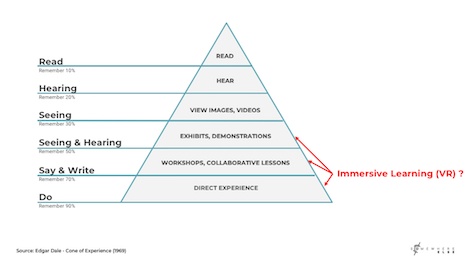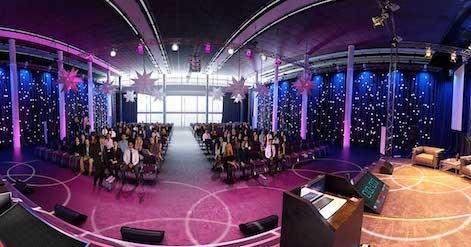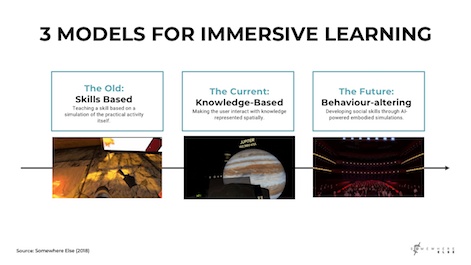Immersive tech and training go back 50 years, but how has that relationship changed? Christophe Mallet and Daniel Fraga from London-based innovation agency, Somewhere Else, explore the popularity of VR training in 2018 and ask whether it will be truly disruptive or just another buzzword.
As VR is evolving, we’re not only learning skills safely through simulations anymore; we have also started to improve cognition and retention of knowledge through immersive learning environments. In the future, with the advent of AI, we will be able to retrain vast portions of our workforce towards better human relationships-driven jobs.
The Past - Learning Skills Through Simulation
Throwback to 1966: The Beatles release Revolver, the Vietnam war rages on and Time Magazine reports on the effects of a strange new substance called LSD. In another mind-expanding event, Thomas A. Furness III creates the first visual flight simulator - and takes the first steps into Virtual Reality (VR) Training.
Furness created these simulators to train US Air Force pilots. He built head-mounted displays so that trainees could experience real-world scenarios too costly or dangerous to recreate in reality. Pilots repeated key tasks and learned incident management tactics in simulated conditions.
This is an example of what we call the skills-based model of VR training - teaching practical skills by using the body as a natural interface, and thus developing physical memory through repetition. With the cost of hardware having dropped in the past few years, the model of the flight simulator is quickly being replicated across multiple task-based jobs. firefighters, crane operators and couriers can be trained in VR today.
The value proposition of skills-based VR training is clear: any number of people can receive first-hand skills-training on-demand and on-location, by using virtual or augmented reality solutions. VR removes significant travel and infrastructure, not to mention the need to recreate costly and potentially hazardous simulations. However, there is more to immersive training than teaching practical skills.

The Present - Improved Cognition And Memorability
Edgar Dale built his Cone of Experience theory in 1969, based on the premise that the medium in which training is delivered is key to learning efficiency. His work shows that we remember 10% of the material we read, 20% of the information we hear, but a staggering 90% of what we do. So where does VR fit in the cone?
90% of the students who learned with VR passed their test, whereas only 40% of students from the other group made the grade.
Researchers in China tested the effects of VR on children’s performance in school. They compared the test results of students that learned about astrophysics with and without VR. 90% of the students who learned with VR passed their test, whereas only 40% of students from the other group made the grade. Short-term retention was up 27% and long-term memorability improved by 32%.
This is the knowledge-based model of VR training. The content is replaced in its spatial context, enhancing cognition. In the classroom, we’re taught through passive learning. In VR, we learn through interactions. It’s mere common sense, for example, that subjects like anatomy or cosmology are more easily studied by interacting with 3D models than by deciphering 2D sketches.
One of the biggest challenges faced by Fortune 500 companies today is the alignment of their employees around a common culture and shared knowledge systems.This is largely due to the difficulties of implementing change quickly and accurately across complex organisations. With virtual reality, companies can now provide continuous expert knowledge-training across their ranks. It helps them create a common, company-wide context, based on continuous learning.
Individually, they create knowledge. Collectively, they build culture.

The Future - Changing Behavior
Today, VR training platforms are built on the skills-based or knowledge-based models. With automation threatening to replace millions of what McKinsey calls, “Predictable physical jobs”, vast portions of the workforce will need to be retrained towards less automatable jobs. Those jobs include management, customer service and other kinds of sophisticated human-to-human interactions. Can we use VR to train for human interactions? To teach empathy? To cure us of a variety of biases?
Affecting behaviour with VR is fast becoming less of a sci-fi question and more one of scalability.
At this point in 2018, affecting behaviour with VR is fast becoming less of a sci-fi question and more one of scalability. VR already uses the body as natural interface, which allows us to simulate social, emotional and even near-spiritual experiences. So from powerful experiences, we can engender perspectives.
In 2013, The Virtual Human Interaction Lab (VHIL) at Stanford University tested the link between VR and empathy in the Superman experiment. Two groups of students, one playing the role of doctors in a helicopter and the others being Superman, were tasked to find and help a child as they flew around a city in VR. Even after the experience, subjects who played Superman continued to show significantly higher levels of empathy than their counterparts. This went to show how subtle VR experience design can create empathy on a subconscious level. Make way for the behavior-altering model.
In the latest wave of VR adoption, the service industry has started training retail, customer service, and insurance staff with basic social simulations. Beyond the service industry, experiences following the behavior-altering model can address the biggest issues of today - and tomorrow. As conversational AI progresses, we will very soon be able to simulate human relationships in immersive environments and train social and humanitarian workers, law enforcement officers and pretty much anyone who has to interact with humans as part of their daily jobs. VR ‘experience design’ will soon be ‘human experience’ design.

Ask yourself: what kind of reality will you build?
We 've barely scratched the surface of how Immersive Technologies will impact the way we learn throughout our lives. As we create our immersive tools and our environments, they affect and design us in return.
Immersive technology training offers us the chance to deeply design human behaviour. The medium is the message, and our medium is reality itself. With this future fast approaching, ask yourself: what kind of reality will you build?
About The Authors
Christophe Mallet and Daniel Fraga are respectively Co-founder and VR Designer at Somewhere Else, a London-based innovation agency specialising in immersive technologies (VR/AR/MR). The studio exists
to partner with brands, agencies and innovators to help them navigate and reach their full potential in the Age of Experience. Check out their recent work with adidas, Three and France Télévisions.













